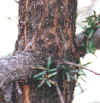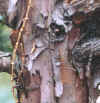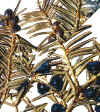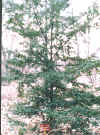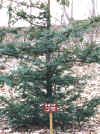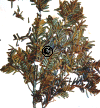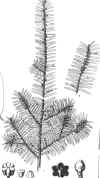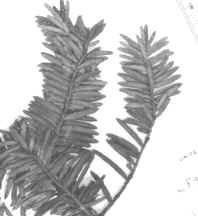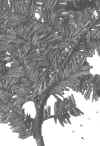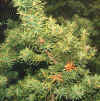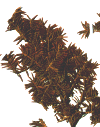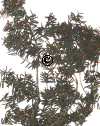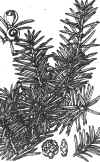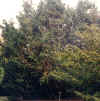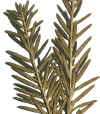10. Leaf blades curved downwards, often arched above the
plane of branchlet................................................... l1
10. Leaf blades straight or curved upwards, or reflexed
at petioles.......................................................... 1411. Branchlets usually leafless below the middle; leaves often in
whorl-like arrangements near apex of branchlets..................... 12
11. Branchlets usually leafy to near base; leaves more
more or less spreading along two sides of branchlets................. 1312. Tall narrow or cylindrical shrubs or trees with erect to ascending
branches; England, Ireland (var. sparsifolia in Scotland,
var. nana in Sardinia.................................. Taxus fastigiata
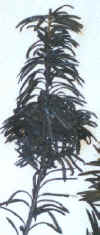 |
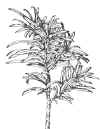
|
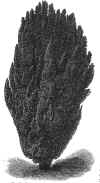
|
|
Left: T. fastigiata,
collected by Lange,
Kew Herbarium (K). Illustrations: center
from Mitchell & Darter (1972), right from Veitch et al. (1880). |
12. Shrubs or pyramidal trees with horizontal branches;
branchlets often recurved or pendant; W Europe (Plants from
Iran with obconical to bell-pepper shaped seeds are referred to
var. subpyamidalis)...................... Taxus baccata var. pyramidalis
13. Leaves crisscrossing more than spreading parallel, at least
near apex of branchlets; widely distributed in the Euro-
Mediterranean, forming yew woodlands on chalk in SE England,
cultivated in arboreta (English yew).................... Taxus recurvata
(var. intermedia is distinguished by mostly rigid, straight
branchlets with leaves more olive green on adaxial surface,
appearing more strongly crisscrossed in dried specimens,
and in tapering to an acute or acuminate apex'
var. linearis has more distant thinner leaves, more abruptly
bent downwards near apex.
Taxus recurvata var. recurvata-Left: Cultivar
'English Yew' in Secrest Arboretum, Wooster
Ohio. Center: branch of live tree in the
Garden of Plants near the Museum of Natural
History. Right: from Yorkshire (Turrill s.n. K).13. Leaves mostly parallel to each other except the uppermost
occasionally at right angles towards apex of
branchlets............................. Taxus baccata var. dovastoniana
Taxus baccata var. dovastoniana. Left: branch
of unlabeled tree at Kew Gardens. Right:
Tree at Kew Gardens labeled cv.'Aurea'.
14. Leaves spreading by bending of the blades, usually
overlapping branchlets near their base when specimens are
pressed, not revolute when dried (except when young); abaxial
surface of leaves usually with (7-) 8-10 (-11) stomata rows in a
band and with a marginal border of (0-)4–7 (-9)rows of cells
lacking papillae.................................................... 15
14. Leaves often sharply bent at the base of the blade, adpressed
against the branchlet, recurved to revolute along margins
when dried; abaxial surface of leaves usually with (9-) 12-15
(-16) rows of stomata in a band and a border of (6-)8–18
(-24)rows of marginal cells without papillae........................ 23
15. Leaves acute to acuminate............................................. 16
15. Leaves obtuse, rounded to abruptly apiculate.......................... 18
16. Dried leaves usually notably dark green above and paler yellowish
green below; Euro-Mediterranean (Plants from the W Himalayas with
conspicuous resin cells in the leaf mesophyll are referred to
T. contorta)............................. Taxus recurvata var. linearis
16. Dried leaves olive green to yellowish green, similar in color
on both surfaces.................................................... 17
17a. Shrubs or trees with distinct leaders................................17b
17b. Branches somewhat decending, the branchlets, however, ascending,
leaves ascending to erect.......... Taxus baccata var. elegantissima
17b. Branches mostly horizontal, often subverticllate; leaves recurved
(downwards).......................... Taxus baccata var. washingtonii
17a. Shrubs spreading more horizontally than upright, lacking a
distinct leader; leaves usually curved upwards; frequent in
cultivation.......... Taxus baccata var. elegantissima cv. 'Repandens'

18. Branchlets nearly in fascicles or appearing digitate,
mostly pendant or spreading recurved, uppermost
leaves directed towards apex of branches; W Euro-
Mediterranean, cultivated as shrubs or as hedges,
especially about government buildings (Dovaston yew)......
...................................... Taxus baccata var. dovastoniana
(Plants from Portugal and Spain with paler green leaves spreading
almost radial are referred to var. erecta if leaves acute or
var. ericoides, which occurs in Morocco, if leaves are acute)
18. Branchlets subpinnate to isodichotomous.............................. 19
19. Branching mostly isodichotomous; branchlets and leaves mostly
in one plane, horizontal........................................... 20
19. Branchlets arranged along a main branch; leaves usually upturned..... 21
20. Adjacent leaves on one side of branchlet with margins nearly
overlapping; leaves relatively thick, not notably curled
when dried, plane to uniformly recurved along margins;
Euro-Mediterranean......................... Taxus baccata var. baccata
Taxus baccata var. baccata. Left to right: lectotype, from Bosnia,
(Curic, K),photo by R. Spjut of live plant at Kew Gardens, from
Nottinghamshire(Bowden & Hillman 433, BM), from Bavaria (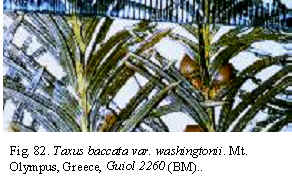 Milchbruder, K) Milchbruder, K)
20. Adjacent leaves on one side of branchlet
distant; leaves relatively thin, more
curled or revolute in upper third when
dried.... Taxus baccata var. washingtonii
(T. recurvata var. linearis differs by
the leaves twisted perpendicular to the
plane of the branch and also leaves are
bent downwards near an obtuse ot acute apex)
21. Branchlets flexuous or pendant, not arched or recurved;
leaves not yellowish orange (Fig.).... Taxus baccata var. jacksonii
21. Branchlets recurved; leaves yellowish to orange................ 22
22a. Branchlets slender; dried leaves glaucous or yellowish orange
on abaxial surface
22b Aril red..................................... Taxus baccata var. glauca
22b Aril yellow............................ Taxus baccata var. fructo-lutea
T. baccata var. glauca. Left to right: cultivated,
from Italy (US). From Ireland (Caruthers BM). Right:
Live plant cultivated at Beltsville Agric. Res.
Center, MD,
23. Leaves spreading mostly along two opposing sides of a
branchlet, erect to horizontal (two-ranked).......................... 24
23. Leaves not consistently in two-ranks, often in whorl-like
arrangements......................................................... 26
24. Leaves spreading more by narrow petioles, more curved than
sharply bent, or curving nearer junction with branchlet
than with blade; most seeds maturing on 2nd yr or older
shoots; stomata (4-) 5–9 (-11) rows/band; leaf papillae
often obscure; plants usually low, creeping
shrubs................................................. Taxus canadensis
24. Petioles more sharply bent near junction with blade, the blades
often (ad)pressed to branchlet; most seeds maturing on shoots of
the current season; stomata (7-) 9–14 (-16) rows/band; papillae
always prominent in stomata bands; plants erect shrubs or trees,
or creeping.......................................................... 25
25. Plants densely branched; branchlets thick, long pendant or rigidly
divaricate or recurved; leaves mostly erect on branchlets,
uniformly recurved along margins when dried; mostly in
cultivation (Cuspidate yew)........................ Taxus cuspidata
25. Plants diffusely branched with spreading horizontal
slender branchlets in a biternate arrangement;
leaves mostly in a horizontal plane, revolute along
margins, especially in upper one third when dried;
common understory tree in SE Russia, NE China, Korea,
Japan; common in cultivation as shrubs
or trees (Delicate-branch yew).................... Taxus biternata
Taxus biternata: Left (1st) column: upper two are from plants
in the Secrest Arboretum, appearing to grow wild as a forest
dominant, lower left is overlapping photos of two herbarium
specimens in the Arnold Arboretum (A), upper one collected by E.
Wilson (10688, with seed) from Korea, lower collected by C. Sargent
from Japan (with purplish dried aril). Column 2: top is more of
Wilson 10688. The remaining photos are from the Forestry Research
Institute in Korea, provided by Kang Hyeon Ka, received as
T.cuspidata var. cuspidata (3rd column) and var. latifolia
(far right column), which here is not considered to be that
variety; however, the differences in the bark between the two
trees suggest cryptic differences in T. biternata to warrant
further taxonomic segregation. The middle photo in second column
corresponds to the tree in the third column, and the lower photo
in the second column corresponds to that in the far right
column as labeled by Kang Hyeon Ka.
26. Leaves mostly imbricate, erect or bent upwards, drying
yellowish to yellowish orange....................................... 27
26. Leaves appearing in a star-like arrangement, or
decussate in several V-formations, some reflexed,
usually twisted with their edges facing upwards,
others on horizontal branchlets nearly in two
ranks, drying dark green (except var. nana)..........................28
27. Leaves and branchlets dense, ascending to erect, the
leaves more in whorls than bending to one-side of branchlets;
introduced from Japan, includes various cultivars.......
(Caespitose yew)
...................................Taxus caespitosa var. caespitosa
  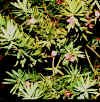 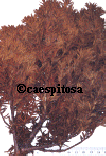 Taxus caespitosa var. caespitosa. Left 3: Cultivars,
in the Secrest Arboretum, Wooster, Ohio; far right:
from Mt. Daisen, Japan (topotype, Makino 43792, S),
Taxus caespitosa var. caespitosa. Left 3: Cultivars,
in the Secrest Arboretum, Wooster, Ohio; far right:
from Mt. Daisen, Japan (topotype, Makino 43792, S),
27. Branchlets and leaves lax, branchlets spreading recurved,
leaves ascending on lateral branchlets, introduced
from Japan and Korea; common in cultivation.............
.....................................Taxus caespitosa var. latifolia
Taxus caespitosa var. latifolia. Left: Faurie
without number from Korea (lectotype P), closer
view of branch in center. Right: Cultivar in
the Secrest Arboretum, Ohio.
|
28. Plants cylindrical with mostly erect branches; branchlets
hardly spreading; leaves mostly linear, revolute when
dried, darker green with age (Hick's yew); the typical
form occasional in cultivation, other variants common;
described from horticulture, possibly native to Japan
..................................... Taxus umbraculifera var. hicksii
28. Plants low rounded bushes to tall trees; branchlets
spreading outwards in various directions;
leaves oblong to linear, plane to recurved along
margins............................................................ 29
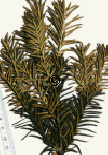 |
 |
 |
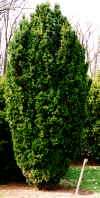
|
|
Taxus umbraculifera var. hicksii:
left margin, holotype (A), above left, cultivated plant in Laurel, MD;
right, 'Citation yew' in the Secrest Arboretum |
29. Leaves overlapping and slightly crisscrossed near apex
of branchlets, mostly in two-ranks below; variable
in habit; SE Russia, Korea, Japan (Small seed yew)....
................................. Taxus umbraculifera var. microcarpa
29. Leaves mostly radial on young shoots................................ 30
Taxus umbraculifera var. microcarpa. Top left: illustration
from Kolensikov (1935). Top right: specimen from Japan,
Herb. Zuccarini in Gray Herbarium (GH). Lower left:
Wilson 8538 from S Korea, Arnold Arboretum Herbarium (A).
Lower center: from SE Russia, Palczevski 3601 (A). Far
right: illustration in Siebold & Zuccarini (1870).
Note the strong similarity in phyllotaxy (leaf arrangement)
represented by specimens from different areas. The specimen
from SE Russia and the illustration in Siebold &
Zuccarini (1870) have thick rigid branches in contrast to
flexuous branchlets in the other specimens. R. A. Keen
annotated the specimen collected by Palczevski 3601 in the
Kew Herbarium (K, July 1966) as T. cuspidata cv. 'Densa'
30. Branchlets stiff, densely compacted; SE Russia,
NE China, Korea, Japan, common in cultivation as a
hedge plant (Dwarf yew).................Taxus umbraculifera var. nana
Taxus umbraculifera var. nana: three left photos-cultivars
in the Secrest Arboretum, the second is a close-up of the
first, the third is a close-up of a plant shown in part in
photo under var. umbraculifera, the far right is a specimen
in the Arnold Arboretum (A) collected by Kypehinova from
Primorsky Province in SE Russia.
30. Branchlets limber; plants diffusely branched; native to Japan,
hybrids developed in cultivation, includes Hatfield yew
(Umbrelliform yew)............ Taxus umbraculifera var. umbraculifera
Taxus umbraculifera var. umbraculifera: Lower left, tall
tree in back, close-up shown above, Secrest Arboretum, also
yellowish green shrub in foreground (in part) is var. nana
for which a close-up is shown under var. nana. Column 2: top
is a close-up, looking down a branch from above, of a
cultivated plant in Rockville, Maryland; below shows the
holotype of the Hatfield yew in the Arboretum Herbarium (A).
Column 3 is a specimen in A collected by Muroi (#30) from
Japan, proposed epitype based on proposed neotype shown
far right, an illustration in Makino, Illustrated Flora of
Nippon, captioned “Taxus cuspidata var. umbraculifera”.
|





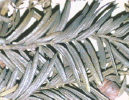




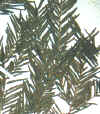



 Milchbruder, K)
Milchbruder, K) 











